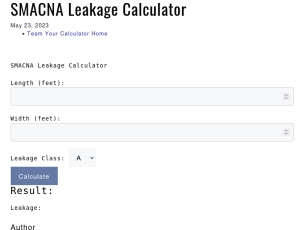SMACNA Leakage Calculator
Leakage:
SMACNA Leakage Calculator
Result:
SMACNA Leakage Calculator
The SMACNA Leakage Calculator is a tool used to estimate the amount of air leakage in ductwork based on the dimensions of the duct and the leakage class defined by the Sheet Metal and Air Conditioning Contractors’ National Association (SMACNA) standards. It helps in determining the potential air leakage in a duct system, which is important for maintaining energy efficiency and indoor air quality.
Try out our Blackbody Radiation Calculator.
Formula and Calculation
The calculation for estimating duct leakage using the SMACNA standards involves the following formula:
Leakage = Length * Width * Leakage Factor
Where:
- “Leakage” represents the estimated air leakage in cubic feet per minute (CFM).
- “Length” refers to the length of the duct in feet.
- “Width” represents the width of the duct in feet.
- “Leakage Factor” is a predefined factor associated with the leakage class.
The leakage factors are specific to each leakage class and are typically provided by SMACNA. They represent the ratio of leakage to the total surface area of the duct. By multiplying the length, width, and the appropriate leakage factor, we can estimate the air leakage in CFM.
Example: Let’s consider an example where we have a duct with a length of 20 feet, a width of 12 feet, and a leakage class B.
Using the SMACNA Leakage Calculator, we can estimate the air leakage as follows:
Leakage = 20 * 12 * Leakage Factor (Leakage Factor for Class B)
Assuming the leakage factor for Class B is 0.50, the calculation becomes:
Leakage = 20 * 12 * 0.50 = 120 CFM
In this example, the estimated air leakage in the duct would be 120 CFM.
FAQs:
- What are the different leakage classes defined by SMACNA? SMACNA defines five leakage classes: A, B, C, D, and E. These classes represent increasing levels of allowable air leakage for different types of duct systems, with Class A having the lowest allowable leakage and Class E having the highest allowable leakage.
- Why is duct leakage important? Duct leakage can significantly impact the energy efficiency and performance of HVAC systems. Excessive air leakage can lead to energy wastage, reduced system effectiveness, and increased energy consumption. Estimating and controlling duct leakage helps ensure optimal system operation and minimizes energy losses.
- Are there any specific guidelines for duct leakage in building codes or standards? Yes, various building codes and standards, including those by SMACNA, ASHRAE, and the International Energy Conservation Code (IECC), provide guidelines for acceptable levels of duct leakage in different applications. Compliance with these standards helps ensure energy efficiency, occupant comfort, and indoor air quality in buildings.

